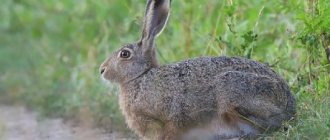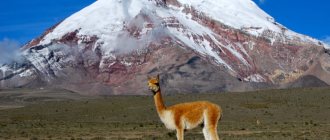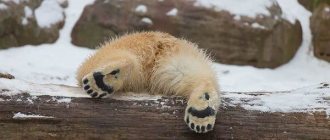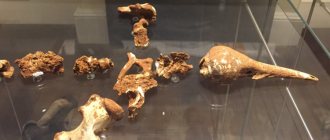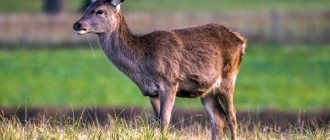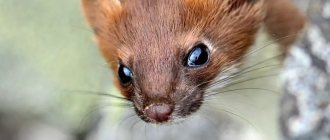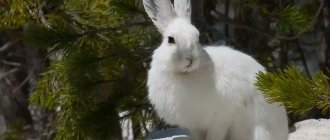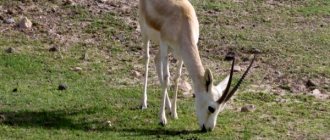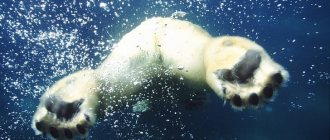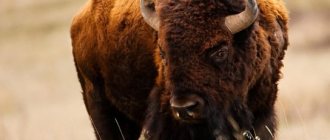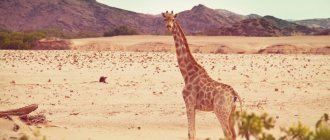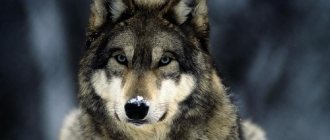The polar hare is the largest among its other brothers. He looks a lot like a rabbit, only his ears are much longer.
This species has perfectly adapted to living conditions in cold areas. It tolerates temperatures well even minus 30 degrees Celsius. Habitat: northern Canada and the tundra of Greenland. But this animal is not found in Alaska.
Arctic hare (Lepus arcticus).
Brief description of appearance
The average length of an adult four-kilogram individual reaches 55-70 centimeters. By analogy with most of its relatives, the Arctic hare has a small fluffy tail and powerful long hind legs, allowing it to quickly jump through deep snow. The animal’s head is adorned with relatively short ears, and its body is covered with thick fur, which helps it better withstand sub-zero temperatures. Hares living in the far north have a white coat. Individuals inhabiting other regions acquire a grayish-blue hue in summer, thanks to which they are easily camouflaged as local vegetation and rocks.
Similarities and differences between the white hare and the brown hare
Both species belong to the same genus. Their main morphological characteristics are the same. But there are also differences.
- The white hare has inhabited forests, thickets and small forests. The hare prefers forest-steppes, fields, meadows and even foothills.
- The brown hare is, on average, a larger animal. He has a longer body, ears, tail, paws.
- The white hare's feet are wider and covered with tough fur. This gives an advantage when driving on snow and loose soil.
- The winter color of the hare is somewhat lighter than the summer color, but not completely white.
The similarities and differences between the white hare and the brown hare are influenced by living conditions and food supply. But in general, these hares are very similar and are perceived by ordinary people as the same animal bearing different names in different calendar periods.
Where does this species live?
The Arctic hare inhabits the northernmost regions of the Canadian Arctic Archipelago and Greenland. It can also often be found in Labrador, Newfoundland and Ellesmere Island. This animal is equally at home in highland and lowland areas. In summer, hares choose areas where vegetation grows quickly. In winter, they move to secluded corners where they do not need to dig deep to get food. They try to avoid wet meadows, preferring to settle in drier areas.
The Arctic hare can make seasonal migrations. Thus, hare hare living in Rankin Inlet move from the mainland to small islands in late spring. The main reason for this relocation is considered to be the smaller number of predators living there.
Lifestyle and habitat
Whites live in mixed and coniferous forests, thickets and small forests. Young undergrowth, forest edges, overgrown outskirts of swamps and river valleys are suitable for existence and reproduction. Hares avoid large open spaces.
white hare lives and feeds on an area of several hectares. These are territorial animals. Violation of boundaries is allowed during the mating season. Hares can undertake forced food migrations or migrations from places with active industrial and economic activity of humans
The animals go out to feed in the evening, at dusk. In summer they are attracted by grass, in winter by willow trees and young aspen trees. Winter or spring grain fields, depending on the season, are especially revered by hares.
The white hare is active all night. After feeding, it goes out for the day. Before lying down, he confuses his tracks. It meanders through the forest, periodically retracing its old trail. Jumps away from its trail far to the side, making so-called “sights”. Does everything to ensure that the scent trail confuses the potential pursuer.
Lies in a thicket. white hare can bury itself in the snow in winter He sleeps very lightly. Tracks rustles and movements in the surrounding space. The hare's vision is not very sharp, and its sense of smell is not very sensitive. Therefore, the hare often gets up and begins to listen.
Most often, the hare settles down in a new place every day. But this rule is optional: multiple days at the same rookery occur. In the event of a severe winter, the hare makes deep snow burrows. They are used repeatedly.
Raised by a predator, the hare leaves at maximum speed, making large intersecting circles and loops, confusing the trail. Having completed the next circle, he returns to the starting point. Feeling that he has become separated from his pursuer, he tries to lie down again.
Hares living in the tundra behave in a peculiar way. They sometimes abandon their status as territorial animals and begin to migrate with the onset of winter. They gather in groups of several tens or even hundreds of individuals and move to areas with a milder climate. Such migration flows have been observed in Yakutia, the polar Urals, and Yamal. In spring, hare herds move in the opposite direction.
What does the arctic hare eat?
The Arctic hare belongs to the category of herbivores. The basis of its diet consists of woody plants. He can also feast on grass, leaves, berries and buds. The animal has a well-developed sense of smell, so it can easily dig up roots and willow twigs hidden under a layer of snow.
In addition, there have been recorded cases of the Arctic hare eating bark, sedge, lichens, mosses and even meat from hunting traps. It can also eat tidal algae. When eating, the hare tries to lean on its hind legs, raking the snow with its front legs, under which edible vegetation is hidden. After eating, they always clean their fur. To get food hidden under a hard layer of snow, the animal hits it with its powerful paws and then begins to gnaw at the ice crust.
Nutrition
The diet of white hare depends on the season and the biotope in which it exists. In the European central zone, hares eat various herbs. The juicier the better. Clover, goldenrod, and dandelion are suitable. In search of nutritious food, they come to the banks of swamps, streams and rivers.
In taiga forests, reindeer truffle is added to herbs. This soil mushroom is a treat for hares. They successfully search for and dig up its fruiting bodies. The further north the habitat, the less picky the hare. Wormwood, sedge and even horsetail are eaten.
As the grasses wilt, white hare move to rough food resources. In winter, hares feed on bark and branches. In any season, agricultural fields with grown grain crops are of great importance for white hare. In addition, hares go onto the roads along which grain is transported and eat up everything that is lost during transportation and overload.
A vegetarian diet causes a lack of calcium and other elements in the hare’s body. The deficiency will be replenished by visiting salt licks, where hares eat soil saturated with minerals. For the same purpose, whites gnaw bones or horns of animals found in the forest.
Features of reproduction
The mating season usually falls in April-May. At this time, whites split into pairs, but one male can have several females at once. The hare, having chosen a secluded place behind rocks or under a bush, digs a hole there and lines it with fur and grass. The average duration of pregnancy for a female is 36-42 days. The closer to the north, the later the hares are born.
In a litter, as a rule, there are from four to eight babies, each weighing 56-113 grams. They are born already sighted, and their bodies are covered with gray-brown hair. Just a few minutes after birth, babies are already able to jump. Two-week-old bunnies become more independent and no longer need their mother so much. By September they look like their parents, and the following season they begin to reproduce.
Hunting for the white hare
This is an event for one or more people. Hunting for hare and white hare is not complete without a hound dog. In the case of collective hunting of a hare, a live line is organized. In its center is a leader with a dog. The remaining participants are located at a distance of 100 steps from each other. The owner of the dog sets guidelines and directs the movement. Constantly urges the dog - he snorts. There may be several dogs, but the principle of action does not change.
The task of the chain of hunters is to raise the hare. The leader must lure the hound onto the trail. The hare lays the first circle. It usually closes at the resting place. If the hare is lucky, he makes a second, wider circle. Hunters hide near the bedding area or where the hare habitually roams. From this location they kill the beast.
A hare moving in circles can throw a dog off the scent. She falls silent for a while, and a silence ensues. A so-called chipping occurs. In this situation, much depends on the experience and training of the dog. A young hound may not understand the tangled tracks of a hare and lose it.
Usually everything ends with a successful shot. The result is traditionally recorded: the hare in the photo is located, as befits a trophy, at the feet of the hunter and his dog.
Features of behavior
Unfortunately, this aspect of the white hare’s life has been studied much less well compared to its relatives. It is known for certain that the Arctic hare is a nocturnal and crepuscular animal. It does not hibernate in winter because it tolerates low temperatures well due to its thick fur and low ratio between the area and volume of its body. It is thanks to this feature that the hare’s body manages to compensate for the slowdown in basal metabolism.
In particularly severe frosts, hares hide behind boulders or in dug holes. They live in relatively small areas, so they go in search of food along the same paths. To escape from predators, these animals can rush at a speed of about 60 km/h.
Enemies
These animals have been hunted for centuries. Their meat was used for food, and clothing was made from their fur. Therefore, man has always been an enemy for the hare. But arctic foxes, stoats and wolves are still more dangerous for this animal. If a hare can hide from people in the snow and, thanks to the white color of its fur, becomes invisible, then the predator will smell it in this case too. In such a situation, only strong legs and fast running can save you. However, with age, animals weaken, they can no longer run away and become easy prey for predatory animals.
Video
Predators
Most often, Arctic hare are hunted by the Arctic wolf. Even young wolves can successfully catch a hare. Arctic foxes, although smaller in size than hares, also hunt them, but not as successfully as wolves. True, young hares are often preyed upon by arctic foxes, and stoats probably also prey on young hares. May become prey for lynx. As for birds, the gyrfalcon poses a particular threat to hares. In the more southern territories of the range, peregrine falcons hunt polar hares. Snowy owls also hunt hares, especially young ones.[17]
Notes
- Complete illustrated encyclopedia. "Mammals" Book. 2 = The New Encyclopedia of Mammals / ed. D. MacDonald. - M.: "Omega", 2007. - P. 440. - 3000 copies. — ISBN 978-5-465-01346-8.
- ↑ 1 2 Canadian Museum of Nature.
[www.nature.ca/ukaliq/021des/030_rng_e.cfm About the Arctic Hare - Range] (English). Retrieved June 11, 2008. [www.webcitation.org/669KJ3V2d Archived from the original on March 14, 2012]. - ↑ 1 2 3 Gianetta, J.
[www.saskschools.ca/~gregory/arctic/Ahare.html Arctic Hare - Information] (English) (unavailable link -
history
) (2000). Retrieved June 11, 2008. [web.archive.org/20020808154900/www.saskschools.ca/~gregory/arctic/Ahare.html Archived from the original on August 8, 2002]. - Canadian Museum of Nature.
[www.nature.ca/ukaliq/021des/020_hbt_e.cfm About the Arctic Hare - Habitat] (English). Retrieved June 11, 2008. [www.webcitation.org/669KJnGY6 Archived from the original on March 14, 2012]. - [www.enchantedlearning.com/subjects/mammals/lagomorphs/Arctichareprintout.shtml Arctic Hare] (English). Retrieved June 11, 2008.
- ↑ 1 2 Gorog, Antonia
[animaldiversity.ummz.umich.edu/site/accounts/information/Lepus_arcticus.html Lepus Arcticus] (English) (2003). Retrieved June 11, 2008. [www.webcitation.org/669KKxP7X Archived from the original on March 14, 2012]. - Canadian Museum of Nature.
[www.nature.ca/ukaliq/021des/010_chr02_e.cfm Arctic Hare - Charasterics] (English). Retrieved June 11, 2008. [www.webcitation.org/669KLYkJQ Archived from the original on March 14, 2012]. - ↑ 1 2 Canadian Museum of Nature.
[www.nature.ca/ukaliq/021des/010_chr03_e.cfm Arctic Hare - Charasterics - 2] (English). Retrieved June 11, 2008. [www.webcitation.org/669KOE9H4 Archived from the original on March 14, 2012]. - ↑ 1 2 Government of Nunavut, Department of Environment.
[www.gov.nu.ca/env/arctichare.pdf Arctic Hare] (English). Retrieved June 11, 2008. [www.webcitation.org/669KPFci0 Archived from the original on March 14, 2012]. - Best, Troy L. & Henry, Travis Hill (1994-06-02). "Lepus arcticus". Mammalian Species 457
: 1-9. DOI:10.2307/3504088. ISSN [worldcat.org/issn/00763519 00763519]. - ↑ 12
[www.ucls.uchicago.edu/students/projects/1996-97/Hillocks96/arctic_hare.html The Arctic Hare] (English). Retrieved June 11, 2008. [www.webcitation.org/669KQ8FZQ Archived from the original on March 14, 2012]. - [www.nhptv.org/natureworks/arctichare.htm Arctic Hare - Information] (English). Retrieved June 11, 2008. [www.webcitation.org/669KQZ73O Archived from the original on March 14, 2012].
- [animals.nationalgeographic.com/animals/mammals/arctic-hare.html Arctic Hare Profile] (English). Retrieved June 11, 2008. [www.webcitation.org/669KR63mK Archived from the original on March 14, 2012].
- [www.americazoo.com/goto/index/mammals/135.htm Arctic Hare] (English). Retrieved June 11, 2008. [www.webcitation.org/669KUT4c5 Archived from the original on March 14, 2012].
- ↑ 1 2 3 Gray, David R.
[pubs.aina.ucalgary.ca/arctic/Arctic46-4-340.pdf Behavioral Adaptations to Arctic Winter: Shelter Seeking by Arctic Hare (Lepus arcticus)] (English) (1993) . Retrieved June 11, 2008. [www.webcitation.org/669KUvSzU Archived from the original on March 14, 2012]. - [www.alexandgregory.com/hares.html Arctic Hares] (English). Retrieved June 11, 2008. [www.webcitation.org/669KW44IY Archived from the original on March 14, 2012].
- Canadian Museum of Nature.
[nature.ca/ukaliq/021des/050_fwb02_e.cfm Arctic Hare - Predators] (English). Retrieved June 11, 2008. [www.webcitation.org/669KWoTgw Archived from the original on March 14, 2012].
